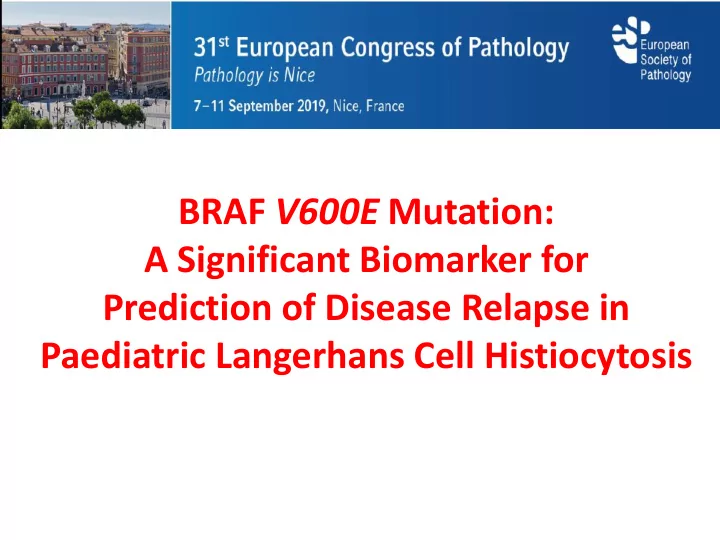

BRAF V600E Mutation: A Significant Biomarker for Prediction of Disease Relapse in Paediatric Langerhans Cell Histiocytosis
• Erdener OZER, MD, PhD * • Akin SEVINC, PhD ** • Dilek INCE, MD * • Resmiye YUZUGULDU, MD * • Nur OLGUN, MD * * Dokuz Eylul University School of Medicine, Izmir, Turkey ** Altinbas University School of Medicine, Istanbul, Turkey
Langerhans Cell Histiocytosis • A rare disease • Usually presenting with a localized disease • Sometimes a widespread aggressive disorder, especially in children. • A strong rationale to stratify high-risk pediatric patients
Langerhans Cell Histiocytosis • Somatic mutations in RAF-MEK-ERK pathway • BRAF mutations have been demonstrated (detection rates up to 69% ) • Associated with multisystem disease and aggressive pediatric LCH • Potential targeted inhibitor therapy and its combination with myeloablative therapy
The Goal of the Study • To investigate the prognostic significance of the mutations of target genes playing a role in the RAF-MEK-ERK pathway in pediatric LCH. • To find a genetic biomarker to predict the disease aggressiveness and a candidate gene for targeted therapy
Material and Methods • 49 patients of pediatric age (0-15 years) • Confirmation of histological diagnosis • Clinical data of prognostic variables: - age and sex, - localization, multifocality (bone), multiorgan - special site and risk organ involvement - CNS risk lesions - relapse and survival
Material and Methods • Risk organ involvement: Bone marrow, liver, and spleen • CNS risk lesions: Craniofacial, ear, eye and oral involvements • Special sites: odontoid peg and vertebral lesions with intraspinal soft tissue extension
Material and Methods • Selection of representative tumor tissue on H&E stained sections • DNA extraction from FFPE tumor tissues • Determination of DNA quality • Designing primers to targeted mutations
Table 1. The list of genomic regions in the targeted sequencing panel
Material and Methods • Designing primers • PCR reaction • 38 DNA samples • Bidirectional Sanger sequencing • Mutational profile • Statistical analysis
Results ◼ Sex ratio (M/F) : 21(55.7%) / 17 (44.3%) ◼ Age <2 yrs:10 (26.3%), 2-18 yrs: 12 (31.6%), >8 yrs: 16 (42.1%) ◼ Single organ:31(81.6%), multiorgan:7(18.4%) ◼ Bone: 32 (84.3%), skin 9 (%23.7%), pulmonary:5 (13.2%)
Results ◼ Risk organ involvement: 7 (18.4%) ◼ Special site involvement: 5 (13.1%) ◼ CNS risk lesions: 21 (55.3%) ◼ Diabetes insipitus: 2 (5.3%) ◼ Follow-up: 7-98 ay months (median 24.5) ◼ Death: 2 (5.3%) ◼ Relapse: (13.2%)
Results ◼ BRAF V600E mutation: 14 cases (36.8%) ◼ ARAF F351L mutation: 1 case ◼ Other genetic loci ( MAP2K1, MAP3K1 ): none
Table 2. BRAF V600E mutational status and clinical parameters in LCH patients (n=38) Clinical parameter BRAF V600E mutated BRAF V600E wild type p value (n=14) (n=24) (univariate analysis) System involvement <0.001 Single-organ 7 24 Multisystem 7 0 Bone lesion* non-significant Unifocal 7 16 Multifocal 5 4 CNS-risk lesion non-significant Present 9 12 Absent 5 12 Skin lesion 0.006 Present 7 * 2 Absent 7 22 Risk organ involvement 0.05 Present 5 2 Absent 9 22 Special-site involvement 0.004 Present 5 0 Absent 9 24 Disease relapse 0.004 Present 5 0 Absent 9 24 Age 0.03 < 2 years 7 3 2-8 years 4 8 >8 years 3 13 * The parameter was evaluated in 32 patients with bone involvement.
Table 2. BRAF V600E mutational status and clinical parameters in LCH patients (n=38) Clinical parameter BRAF V600E mutated BRAF V600E wild type p value (n=14) (n=24) (univariate analysis) Skin lesion 0.006 Present 2 7* Absent 22 7 Risk organ involvement 0.05 Present 2 5 Absent 22 9 Special-site involvement 0.004 Present 0 5 Absent 24 9 Disease relapse 0.004 Present 0 5 Absent 24 9 Age 0.03 < 2 years 3 7 2-8 years 8 4 >8 years 13 3 * Five cases (71.8%) were multisystem disease with significantly higher BRAF V600E mutation rate than skin only cases ( P =0.009)
Results ◼ Logistic regression test showed statistical significance of BRAF V600E mutation in relapse positive cases ◼ BRAF V600E mutation was positive in 2 non- survived cases (not statistically significant)
Conclusions ◼ BRAF V600E mutation is a prognostic genetic biomarker in LCH ◼ Also a predictor of disease relapse correlated with multisystemic disease ◼ A candidate marker for either generating a revised treatment guideline or developing a targeted-therapy
Conclusions ◼ BRAF V600E mutation is a prognostic genetic biomarker in LCH ◼ Also a predictor of disease relapse correlated with multisystemic disease ◼ A candidate marker for either generating a revised treatment guideline or developing a targeted-therapy
Conclusions ◼ BRAF V600E mutation is a prognostic genetic biomarker in LCH ◼ Also a predictor of disease relapse correlated with multisystemic disease ◼ A candidate marker for either generating a revised treatment guideline or developing a targeted-therapy
Thank you… @ERDENEROZER erdener.ozer@deu.edu.tr
Recommend
More recommend